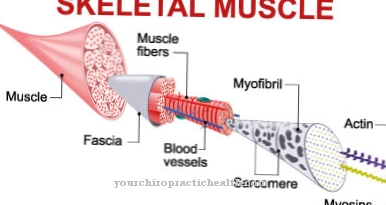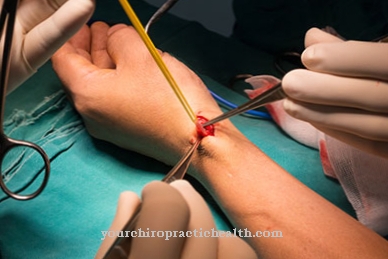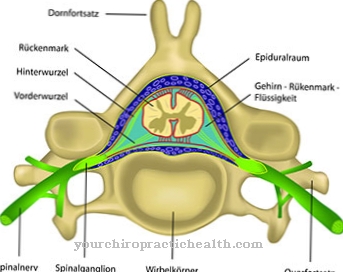In the Testicular atrophy it is pathologically reduced testicles (Shriveled testicles). Severely reduced testicles are usually no longer functional, i.e. neither hormones nor intact sperm are produced. The cause is e.g. Years of abuse of anabolic steroids in question, but also genetic defects, e.g. Klinefelter syndrome or inflammation of the testicles.
What is testicular atrophy?

© joshya - stock.adobe.com
Under one Testicular atrophy the doctor understands conspicuously smaller testicles. While normal sized testicles have a volume of about three cubic centimeters, shrink testicles are sometimes only about one cubic centimeter.
Shrunken testicles are usually no longer functional - the man suffers from azoospermia and - if both testicles are affected - is unable to produce. The sex hormones produced in the testes - especially testosterone - are no longer produced.
causes
The causes of a Testicular atrophy are very different. Shrink testicles are relatively widespread in sports circles, where anabolic steroids are consumed in large quantities to support muscle building.
Various congenital genetic defects, such as Klinefelter's syndrome, are another cause. In addition, untreated and incompletely healed inflammation of the testicle can lead to shriveled testicles. As part of a sex-changing therapy, transsexual men can induce shrink testicles by taking female sex hormones (estrogens) in order to prevent the testicles from unwanted release of the male sex hormone testosterone.
Circulatory disorders (varicocele) or general trauma are less common causes of testicular atrophy.
Symptoms, ailments & signs
Testicular atrophy can be seen optically from the significant reduction in testicular volume. In addition, there is sometimes pain and an uncomfortable feeling of pressure in the testicle area. Discoloration of the scrotum can occur, which increases as the disease progresses and is a clear indication of atrophy of the testes. Testicular atrophy is also linked to infertility and erectile dysfunction.
If the testicular atrophy is caused by inflammation, it usually progresses insidiously and unnoticed. Those affected often only notice them when erectile dysfunction occurs repeatedly or a desire to have children remains unfulfilled for a long period of time. If drugs or growth hormones are the cause, shrink testicles usually develop quite quickly and without pain.
The testicular atrophy itself does not cause any further physical complaints. However, it can sometimes lead to severe psychological problems. Due to the shrinking of the testicles and the associated infertility, inferiority complexes, social anxiety and depression can arise.Often the partners are also affected by the psychological complaints. For this reason, it is recommended that you see a doctor at the first symptoms of testicular atrophy. Early treatment can often reverse the atrophy and avert impending infertility.
Diagnosis & course
A urologist can do one Shriveled testicles relatively easy to diagnose as it is clearly visible. To determine the exact size, the urologist can perform a sonography (ultrasound examination).
If the causes of the testicular atrophy are not obvious - for example in the case of sex-changing therapy for transsexual men or in the presence of Klinefelter syndrome - the urologist will clarify the causes as part of the diagnosis, such as the presence of a varicocele or inflammation.
In addition, the urologist can check the functionality of the testicles by doing a spermogram. If azoospermia is present, there are no sperm in the ejaculate. In this case the testicles have ceased to function and the man is unable to procreate. The course or formation of a shriveled testicle is very different depending on the cause.
While testicular atrophy caused by inflammation usually progresses insidiously and unnoticed and is only noticed when the desire to have children is not fulfilled, shrink testicles formed by the consumption of medication or anabolic steroids form very quickly. The development of testicular atrophy is usually painless.
Complications
Due to the large size of the testicles, they are in most cases without function. This can mean not only physical but also severe psychological discomfort for the patient. As a rule, this leads to infertility, which can often lead to depression or reduced self-esteem. Often this also leads to inferiority complexes.
Not infrequently the partners are also affected by psychological complaints and thus also suffer from testicular atrophy. Furthermore, testicular atrophy has no particular negative effects on the health of the person concerned. In many cases the psychological complaints can be treated by a psychologist without complications. The life expectancy of the patient is usually not influenced by the disease and is therefore not reduced.
If the testicular atrophy occurs due to a circulatory disorder, this is usually treated first. Furthermore, other options for pregnancy can also be used with the partner. Not infrequently, the symptom also occurs in people who want to change their sex. However, testicular atrophy is not treated. There are no further complications from this disease.
When should you go to the doctor?
Testicular atrophy does not always require medical treatment. Less pronounced shriveled testicles will regress by themselves as soon as the causative preparation has been discontinued. Disease-related testicular atrophy should be clarified by a specialist. Children who suffer from Klinefelter syndrome or a comparable disease need medical treatment in any case. Parents should consult a doctor at the first signs of testicular atrophy and have the symptoms examined and treated if necessary.
If the shrink testicles are accompanied by pain or other symptoms, medical treatment is also required. Men who are infertile due to testicular atrophy are best to speak to their family doctor. A visit to a therapist can also be useful. In any case, pathologically smaller testicles must be examined in order to narrow down the possible causes and take suitable countermeasures. People who have had testicular atrophy from birth are best to speak to a specialist doctor. It is often possible to insert implants or to enlarge the shrunken testicles through hormonal measures.
Doctors & therapists in your area
Treatment & Therapy
Depending on the cause, the treatment is one Shriveled testicles very different. If the shrunken testicle is wanted - which is the case with transsexual men who want to undergo a sex reassignment - a shrunken testicle is not treated.
If the shrink testicles have been triggered by taking anabolic steroids, it is advisable to refrain from taking the preparations again. Sometimes the shriveled testicles recede after the preparations have been discontinued. The same applies if there is a circulatory disorder - after the varicocele has been surgically removed, the blood flow can be normalized.
The consequences of shrunken testicles can be counteracted by administering various testosterone-containing drugs. If the man is already suffering from azoospermia, artificial insemination with simultaneous TESE can be used to try to bring about a pregnancy in the partner.
If the shrunken testicle causes pain or the man suffers from the appearance, removal of the shrunken testicle and insertion of an implant can be considered.
You can find your medication here
➔ Medicines for potency and erection problemsOutlook & forecast
With testicular atrophy, the testicles are significantly smaller. In addition, pain and an uncomfortable feeling of pressure in the testicular region occur. In addition, discoloration or sensitivity disorders can occur. Testicular antrophy is usually associated with erectile dysfunction or even infertility. If inflammation is the cause of the shriveled testicles, the signs of the disease become increasingly stronger. The atrophy is often only noticed when erectile dysfunction occurs repeatedly or the testicles have become significantly smaller. As the disease progresses, the pain can radiate to the buttocks and abdomen, causing the patient to feel very unwell.
Untreated testicular atrophy can lead to the loss of one or both testicles. On the other hand, emotional complaints develop, such as depression or inferiority complexes. If the testicular atrophy is based on drug abuse, various accompanying symptoms can also occur. Possible symptoms that occur in connection with shrunken testicles are digestive problems, cardiovascular problems such as palpitations or fluctuations in blood pressure, and skin changes such as acne or redness.
If the cause of the testicular atrophy is not corrected, the disease progresses progressively and, depending on the trigger, can lead to organ disorders, infertility and mental disorders. Atrophy treated at an early stage often subsides without any long-term effects.
prevention
Shriveled testicles themselves cannot be prevented. However, every man can minimize the risk of developing (unwanted) shriveled testicles. This includes not taking anabolic steroids as well as going to the urologist as soon as the person concerned feels pain that suggests inflammation of the testicle.
If the man feels a varicose vein (varicocele), he should also consult a doctor. As a rule, early treatment of a shrunken testicle can prevent the consequences of azoospermia with the inability to conceive.
Aftercare
Follow-up care for testicular atrophy depends on the cause of the disease and the therapy carried out. If anabolic steroids have been misused, no anabolic steroids may be consumed even after the therapy has ended, otherwise there is a risk of renewed atrophy. If a circulatory disorder due to a varicose vein was the cause and the therapy was carried out by surgically removing this varicocele, the patient must cool his scrotum with ice for the first 24 hours after the procedure to prevent bleeding and swelling.
The following day, there is a check-up by means of ultrasound and a wound control, with subsequent discharge of the patient. During the first week, the person concerned is not allowed to perform heavy physical work or play sports. Then a check-up appointment with the local urologist is indicated, to whom the discharge letter from the clinic is to be presented. Six weeks after the operation, the final check-up takes place in the treating clinic. Interfering residues of the self-dissolving suture material can be removed here.
If the prescribed testosterone therapy does not permanently reduce the atrophy significantly to its original size, the removal of the testicle and the insertion of an implant can be considered. This is recommended if there is pain or psychological suffering due to aesthetics. After six to twelve months, a semen analysis can be used to make a statement about the remaining fertility.
You can do that yourself
What people who have testicular atrophy can do themselves depends on the cause of the disease. If a certain drug is responsible for testicular atrophy, treatment consists of discontinuing the responsible drug or changing the medication. If the shrink testicles appear after taking anabolic steroids, the causative preparation should be avoided. At the same time, a medical clarification of the testicular atrophy is always necessary. Most often, medication must be taken to promote recovery. An individual diet may help treat the shriveled testicles. This always depends on how severe the testicular atrophy is and whether accompanying symptoms occur.
Testicular atrophy that occurs in connection with sex reassignment is desired by those affected and therefore does not need to be treated.
In the case of azoospermia, testicular atrophy can no longer be counteracted. The most important self-help measure is to reduce any mental suffering by going to a self-help group at an early stage. Sometimes it makes sense to see a therapist. In addition to medication, pain can be alleviated with various natural remedies. However, this should be discussed with the attending physician beforehand.

.jpg)











.jpg)

.jpg)
.jpg)











.jpg)